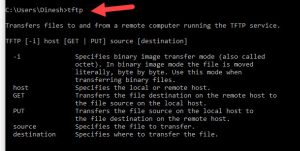

It could have been relative to where we started TFTPD on the Apple II, but I like being explicit. The ‘-l plasma.system’ gives the local name of the file and the ‘-r /CFFA/PLASMA.SYSTEM#FF2000’ gives the remote file name. The –put option tells atftp that we are sending a file to the server. Let’s break this down: The IP address is the address displayed by the Apple II when it started TFTP. Copying a file from Linux to Apple II using the command line: atftp 192.168.123.108 -put -l plasma.system -r /CFFA/PLASMA.SYSTEM#FF2000 This only works for MacOS and Linux, Windows uses both carriage-return and newline which doesn’t convert easily. If you set your TFTP client to ‘netascii’ mode, TFTPD will do the conversion of linefeed to carriage-return and vice-versa when copying text files. The TFTPD server on the Apple II will use the CiderPress ProDOS filename metadata extension so you can set the ProDOS TYPE and AUX values with standard clients. I will use atftp under Linux for my examples as I was using A2Pi for my development machine.
#Mac tftp client commands install
You can install with your Linux package manager of choice. Linux: I have used Advanced TFTP (atftp) with good results. It doesn’t have the extended command line options that atftp has, though. MacOS: A tftp client is included with MacOS, accessible from the command line. Go to” Control Panel=>Programs=>Turn features on or off” and scroll down to TFTP Client.

Windows 10: You already have a TFTP client, it just has to be enabled. On your modern computer, you will need to install a TFTP client. The Apple II will display its IP address which you will need later with the TFTP client. The IP address will be fetched from a DHCP server and the Apple II will be ready to transfer files. The disk will spin as the modules are loaded and the network card should be auto-detected. Once booted, you should see the PLASMA startup message. Simply boot the floppy in your Apple II with Uthernet I or Uthernet II card installed.
#Mac tftp client commands download
You can download the bootable PLASMA System floppy from GitHub: PLASMA-SYS1.PO I wrote the TFTP server and ported it back to the stable branch of PLASMA Version 1.1 (the server found a bug with the PLASMA 2.0 network module loading I’m still working out). The Trivial File Transfer Protocol fits the bill perfectly. However, as I have a nice network stack under PLASMA for these cards, I decided to build an industry-standard file transfer program. As many know, ADTPro has fantastic support for file copying using the Uthernet cards. Since I have both an Uthernet and Uthernet II card, it made sense to use these for file transfers. While working on the PLASMA 2.0 development branch, it occurred to me that copying files by floppy was just too retro.


 0 kommentar(er)
0 kommentar(er)
